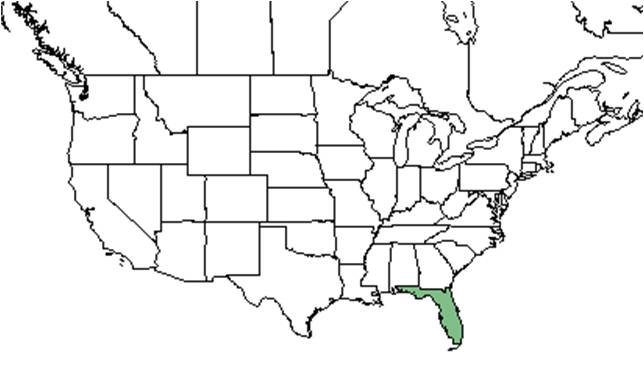Difference between revisions of "Polygala rugelii"
KatieMccoy (talk | contribs) (→Distribution) |
KatieMccoy (talk | contribs) (→Description) |
||
| Line 24: | Line 24: | ||
==Description== | ==Description== | ||
<!-- Basic life history facts such as annual/perrenial, monoecious/dioecious, root morphology, seed type, etc. --> | <!-- Basic life history facts such as annual/perrenial, monoecious/dioecious, root morphology, seed type, etc. --> | ||
| + | ''P. rugelii'' is an annual species, however, sometimes can be a biennial. In the spring, the irregular rosette is composed of spatulate leaves. The flower stalk arises in summer and the basal rosette will disappear. The stalk can reach 1 to 3 feet high and is often branched<ref name="hawthorn"/>. | ||
==Distribution== | ==Distribution== | ||
Revision as of 10:40, 23 February 2016
| Polygala rugelii | |
|---|---|

| |
| Photo by Wayne Matchett, SpaceCoastWildflowers.com | |
| Scientific classification | |
| Kingdom: | Plantae |
| Division: | Magnoliophyta - Flowering plants |
| Class: | Magnoliopsida – Dicotyledons |
| Order: | Fabales |
| Family: | Polygalaceae |
| Genus: | Polygala |
| Species: | P. rugelii |
| Binomial name | |
| Polygala rugelii Shuttlw. ex Chapm. | |

| |
| Natural range of Polygala rugelii from USDA NRCS Plants Database. | |
Common name: yellow milkwort
Contents
Taxonomic notes
It is named for the German botanist, Ferdinand Rugel, who collected plants in Florida during the early 1800s[1].
Description
P. rugelii is an annual species, however, sometimes can be a biennial. In the spring, the irregular rosette is composed of spatulate leaves. The flower stalk arises in summer and the basal rosette will disappear. The stalk can reach 1 to 3 feet high and is often branched[2].
Distribution
P. rugelii is endemic to the Florida peninsula[2].
Ecology
Habitat
In the Coastal Plain in Florida, P. rugelii can occur in wiregrass/saw palmetto/pine associations, cypress bays and flatwood marshes. It has occurred in disturbed areas such as cleared pine flatwoods and a recently timber harvested bayhead (FSU Herbarium). It grows in peaty-sandy soil (FSU Herbarium). Associated species include wiregrass, saw palmetto, pine, and cypress (FSU Herbarium).
Phenology
Seed dispersal
Seed bank and germination
Fire ecology
Pollination
The following Hymenoptera families and species were observed visiting flowers of Polygala rugelii at Archbold Biological Station (Deyrup 2015):
Apidae: Mellisodes communis
Halictidae: Augochlorella gratiosa
Megachilidae: Megachile brevis pseudobrevis
Sphecidae: Ammophila pictipennis
Use by animals
Diseases and parasites
Conservation and Management
Cultivation and restoration
Photo Gallery
Flowers of Polygala rugelii Photo by Wayne Matchett, SpaceCoastWildflowers.com
References and notes
Deyrup, M.A. and N.D. 2015. Database of observations of Hymenoptera visitations to flowers of plants on Archbold Biological Station, Florida, USA.
Florida State University Robert K. Godfrey Herbarium database. URL: http://herbarium.bio.fsu.edu. Last accessed: November 2015. Collectors: A. Gholson Jr., Robert K. Godfrey, R.A. Norris, A.G. Shuey. States and Counties: Florida: Gilchrist, Manatee, Volusia. Compiled by Tall Timbers Research Station and Land Conservancy.
